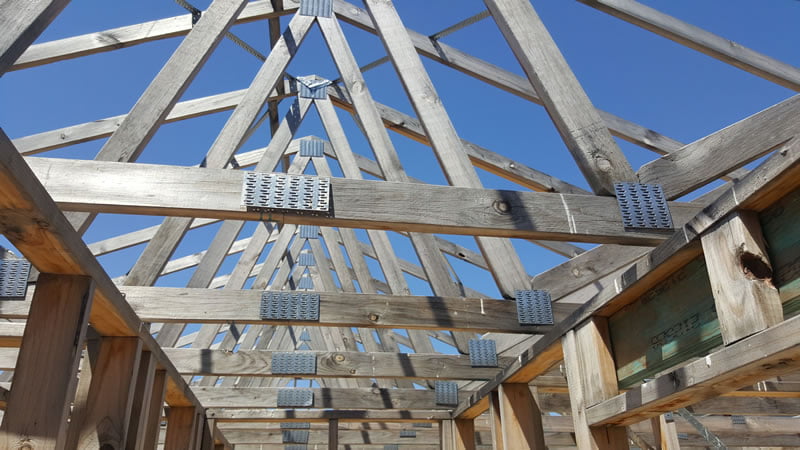What happens when trusses are left in the air. By Brett Bolden, MiTek state engineering manager, Victoria.
Lately, I have been called out to inspect installed roof trusses that have been left exposed to the weather for very long periods of time. I’m not referring to a couple of months or so. Some of these bare-framed buildings have remained uncovered for a year or more due to builders going bankrupt.
When the work resumes, everyone naturally wishes to continue closing the building in as though there was no interruption. But are the trusses still as good as the day they were supplied? What are some of the things that could have changed?
Timber Weathering
Not only does exposed timber become weathered in appearance, the multiple cycles of rain and sunshine beating on the trusses, and the repetitive wetting and drying of timber, if prolonged too long, can lead to splitting, warping and buckling. Different timbers and building products weather in various degrees of severity. LVL in particular is likely to delaminate under such conditions.
So the first thing that can deteriorate is timber strength.
Fungal Damage
Where moisture is present in timber for long periods of time, fungal damage or rot may begin. Rot can be deceptive, because whereas the timber may appear whole on the surface, in reality the insides could be being eaten away by fungi. It’s especially easy to miss if the timber has been painted.
Clock another potential hidden risk of timber strength deterioration.
Timber Distortion
Roof and floor trusses are not only expected to be strong enough, the Building Code also expects them to perform under serviceability. Prolonged exposure causes timber to distort and sag. Pre-cambers are gone and in their stead are differential deflections between trusses. It’s easy to see how this manifests with performance issues down the track.
Two possible solutions to mitigate these problems include modifying trusses to be supported off internal supports to re-level trusses and minimise future deflections, and battening ceilings to level ceilings.
Serviceability problems should not be ignored, and left behind for the homeowner to face down the line.
Nailplate Backout
Wetting and drying of timber also damages nailplated joints, by ‘walking’ the nailplates out further and further as the underlying timber swells and shrinks repeatedly. In a 2009 investigation into mechano-sorptive nailplate backout, the CSIRO concluded that cyclical variation of moisture is the primary cause of this effect. When the joints were tested under tension load in their lab, the rate at which backout occurred rose as the load increased.
Although the nailplates in badly weathered timber may not seem to have backed out much, there may already be the potential to do so in the long term after the roof is loaded. Consequently, the joints may all need to be secured against backout with screws and/or plywood gussets.
Loose/Damaged Metal Parts
All fixings and connections should also be inspected, and re-tightened or replaced, as fixings can work their way loose or become slack with exposure. There may also be excessive corrosion of building products that could warrant rectifications or replacements.
In summary, it cannot be assumed that a structure is OK after being left to weather for a very long time. At the very least, you should get approval from your truss supplier for warranty, expert advice from a timber specialist, and truss re-certification from a qualified engineer.
The cost of replacement may not end up being that much more than the cost of consultant fees and rectifications, especially when there is a big risk of an expensive call back at a later date. Place yourself in the shoes of the homeowner; would you accept this structure in your own house?








